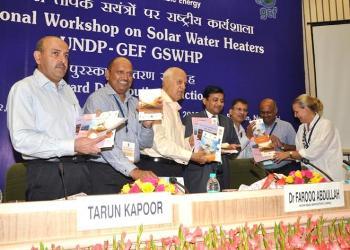India: MNRE Releases Guidelines for High-Rise Buildings
November 27, 2012
 With a growing demand for all urban structures to fulfil solar bye-laws on hot water supply, the Indian Ministry of New and Renewable Energy (MNRE) has released guidelines on how to install solar water heating systems in high-rise and multi-storey buildings.These guidelines include recommendations for system sizes, as well as quality measures for the hydraulic and mounting system. The photo shows the Federal Minister of New and Renewable Energy, Dr Farooq Abdullah, at the national solar water heating workshop on 23 August in Dehli.
With a growing demand for all urban structures to fulfil solar bye-laws on hot water supply, the Indian Ministry of New and Renewable Energy (MNRE) has released guidelines on how to install solar water heating systems in high-rise and multi-storey buildings.These guidelines include recommendations for system sizes, as well as quality measures for the hydraulic and mounting system. The photo shows the Federal Minister of New and Renewable Energy, Dr Farooq Abdullah, at the national solar water heating workshop on 23 August in Dehli.
Photo: Jaideep Malaviya
A team of experts had drafted the guidelines together with some of the leading manufacturers in the country, the School of Energy Studies of the University of Pune (UoP) and the MNRE (see the attached documents). UoP’s commitment to this project earned the university the status of the ministry’s Best Knowledge Partner during the solar water heating workshop in Dehli.
As a rule of thumb, the hot water requirements would be about 20 litres per person for only bathing and about 30 litres per person if used for bathing and washing. The experts assume a general daily hot water demand of 100 litres for a two-bedroom flat and 200 litres for a three-bedroom flat, in case individual systems are installed for each flat. If, however, a community system supplied hot water to several flats, there requirements may increase by about 25%, depending on the number of living spaces.
The guidelines’ final chapter also lists ten solar thermal system providers which help install solar thermal systems in multi-storey buildings. Some of the important guideline requirements for solar water heaters are:
- System oversized by 25% compared to individual systems caused by the losses of long piping and the extra-consumption of hot water from the central hot water supply system
- System split into number of units, with each unit supplying hot water to separate building wing
- Distributed/Split hot water tanks running parallel, with topmost tank of smaller capacities installed in middle floors,including electronic control to heat water if required so that supply to lower flats is quicker
- Shade-free installation area of 3 to 4 m² per 100 litres and day
- Alternative means to ensure equal distribution of hot waterat specified temperature even during non-sunshine hours
- Instant electric geyser to guarantee immediate hot water availability when opening the tap during days without sunshine
- To avoid damage to terrace waterproofing and waste accumulation, solar collectors may be installed on a fabricated structure
- Concealed piping in flat, with suitable outlet set up outside the bathroom, in order to connect to SWH top through insulated piping.
More information:
http://mnre.gov.in/file-manager/UserFiles/guidelines_for_installation_of_SWHS_in_high_rise_buildings.pdf


